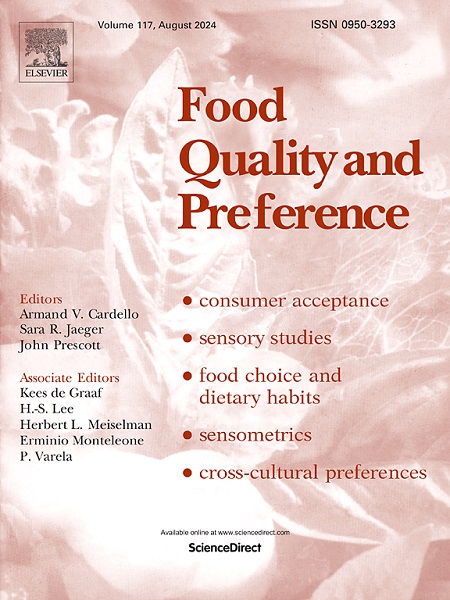Genetic and physiological influences on sweet taste preference among young adults in Malaysia: Associations with TAS1R2/TAS1R3 variants, body composition, and food liking and intake frequency
IF 4.9
1区 农林科学
Q1 FOOD SCIENCE & TECHNOLOGY
引用次数: 0
Abstract
This study explored the relationship between sweet taste preference, TAS1R2/TAS1R3 gene variants (rs35874116 and rs307055), body composition, and food liking/intake frequency among 173 participants in Malaysia (87 males; median age 21 ± 2 years; median BMI 21.800 ± 5.050 kg/m2). Sweet liking was assessed using a Forced-Choice Paired-Comparison task with five increasing sucrose concentrations, along with intensity perception and pleasantness rating of a 36 % sucrose solution. Anthropometric and body composition measurements, as well as food liking and intake frequency data, were collected. Genotyping of TAS1R2/TAS1R3 variants was conducted using real-time allele-specific PCR. Males exhibited a significantly greater preference for higher sucrose concentrations (p = 0.024) and greater liking for 36 % sucrose (p = 0.020) than females. Higher total body fat was positively associated with greater liking for 36 % sucrose solution (p = 0.014). The rs35874116 C allele was more prevalent among low and medium sweet likers and less frequent among high sweet likers (p = 0.028). This allele was also associated with lower liquor preference (p = 0.012) and higher fruit preference (p = 0.013). The CC genotype of rs35874116 was associated with a lower prevalence of overweight/obese (p = 0.028). In contrast, the rs307055 T allele was associated with higher central adiposity, as indicated by increased waist circumference (p = 0.005) and waist-hip ratio (p = 0.004). High sweet likers showed a greater processed food preference (p = 0.049) and a lower fruit intake frequency (p = 0.012) compared to low sweet likers. In conclusion, sweet taste preference in this Malaysian sample is influenced by sex, body composition, and rs35874116/rs307055 gene variants, which might also play a role in influencing food liking and intake patterns.
马来西亚年轻人对甜味偏好的遗传和生理影响:与TAS1R2/TAS1R3变异、身体组成、食物喜好和摄入频率的关系
这项研究探讨了甜味偏好、TAS1R2/TAS1R3基因变异(rs35874116和rs307055)、身体组成和食物喜好/摄入频率之间的关系,研究对象为马来西亚的173名参与者(87名男性;中位年龄21±2岁;中位BMI为21.800±5.050 kg/m2)。对甜味的喜爱程度是通过一项强迫选择配对比较任务来评估的,该任务包括五种增加的蔗糖浓度,以及对36%蔗糖溶液的强度感知和愉悦度评级。收集了人体测量和身体成分测量,以及食物喜好和摄入频率数据。采用实时等位基因特异性PCR对TAS1R2/TAS1R3变异进行基因分型。雄性对高浓度蔗糖的偏好显著高于雌性(p = 0.024),对36%蔗糖的偏好显著高于雌性(p = 0.020)。较高的体脂与更喜欢36%的蔗糖溶液呈正相关(p = 0.014)。rs35874116 C等位基因在低、中甜味偏好者中更为普遍,在高甜味偏好者中较少出现(p = 0.028)。该等位基因还与较低的白酒偏好(p = 0.012)和较高的水果偏好(p = 0.013)相关。rs35874116的CC基因型与较低的超重/肥胖患病率相关(p = 0.028)。相比之下,rs307055 T等位基因与较高的中心性肥胖相关,如腰围增加(p = 0.005)和腰臀比增加(p = 0.004)。与不太喜欢甜食的人相比,高度喜欢甜食的人表现出更大的加工食品偏好(p = 0.049)和更低的水果摄入频率(p = 0.012)。综上所述,马来西亚人的甜味偏好受到性别、身体成分和rs35874116/rs307055基因变异的影响,这些基因变异也可能影响食物偏好和摄入模式。
本文章由计算机程序翻译,如有差异,请以英文原文为准。
求助全文
约1分钟内获得全文
求助全文
来源期刊

Food Quality and Preference
工程技术-食品科技
CiteScore
10.40
自引率
15.10%
发文量
263
审稿时长
38 days
期刊介绍:
Food Quality and Preference is a journal devoted to sensory, consumer and behavioural research in food and non-food products. It publishes original research, critical reviews, and short communications in sensory and consumer science, and sensometrics. In addition, the journal publishes special invited issues on important timely topics and from relevant conferences. These are aimed at bridging the gap between research and application, bringing together authors and readers in consumer and market research, sensory science, sensometrics and sensory evaluation, nutrition and food choice, as well as food research, product development and sensory quality assurance. Submissions to Food Quality and Preference are limited to papers that include some form of human measurement; papers that are limited to physical/chemical measures or the routine application of sensory, consumer or econometric analysis will not be considered unless they specifically make a novel scientific contribution in line with the journal''s coverage as outlined below.
 求助内容:
求助内容: 应助结果提醒方式:
应助结果提醒方式:


